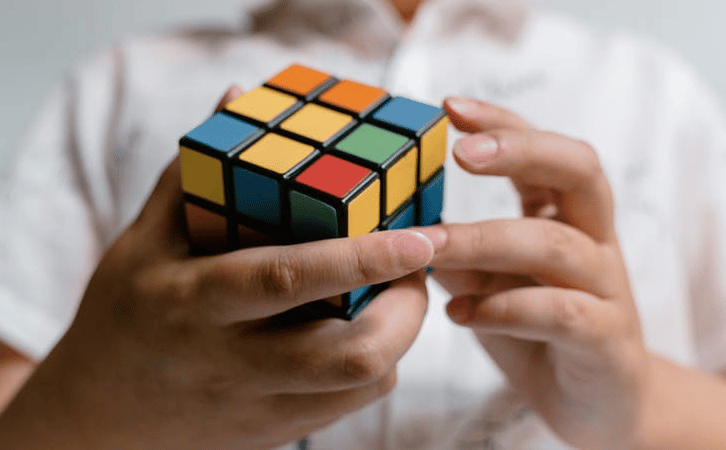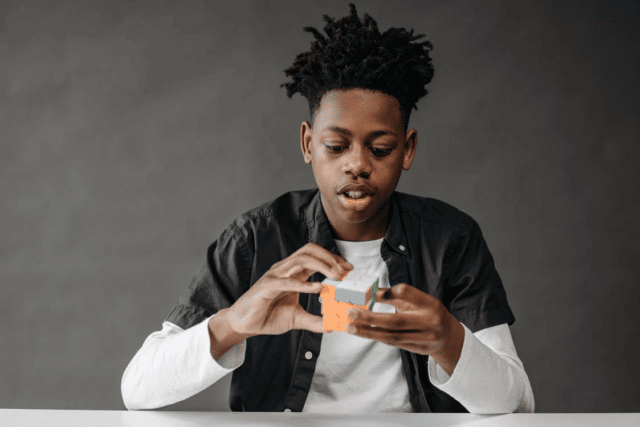
Solving a Rubik’s Cube – 8 Benefits for Kids
We all probably have one of “those” sitting in our basement or at the bottom of whatever toys the adults had when they were younger. But like it or not, the Rubik’s Cube is here to stay, and there are a lot of great things that kids can learn from trying to tackle this ’70s invention.
What is a Rubik’s cube?
This multi-colored cube isn’t just any puzzle. Also known as the Magic Cube, it was casually created by Hungarian sculptor and architecture professor Erno Rubik in 1974. But even he didn’t know the impact his invention would have on the world, it was the real brain games.
It was dubbed the “100 most impactful inventions of the twentieth century” and even if its popularity peaked in the 80s, it’s still a well-known and widely used toy. We could go on and on about the awards it’s won and the complicated algorithms that go into the design.
But today we are looking at how it best benefits children. So, let’s take a closer look…
Teaches Patience
The Rubik’s cube is not something most people can solve in a few minutes. Even regular, table-top puzzles give us a border to start with and color clusters to move us along.
But with this game, children have no choice but to sit down and REALLY give those their twists and turns and fair chance. They also have no choice but to learn patience if they must “start from the beginning” or “get completely” lost. It’s an “unforgiving puzzle” but in an educational way.
Encourages Short-Term Memory
People who have studied this game have said it helps to “map out” your steps. Younger children may not be able to use a hulked-out version of short-term memory to remember what they’ve done, but they will have to use it regardless.
And no, using a pen and paper to mark down moves is NOT cheating. It’s an exercise in organization and planning and should be encouraged.
Great for Hand-Eye Coordination
Ohhhhh the Rubik’s cube is great for this skill. The player has to identify colors and patterns and then decide which turn to take to move further along the puzzle process. Side note, dexterity and agility practice for seniors is great too and the R-Cube is fantastic for them as well.
Encourages Creativity
This one is pretty obvious. As your child turns the puzzle, they will see color clusters appear. They will then start looking for other colors to join the fold – maybe even by looking a few steps ahead. It’s a beautiful exercise in simple, yet powerful creativity.
But it’s not just the end goal that requires tricky thinking. Getting out of a dead end needs just as much imagination.

Pushes Concentration
Duh – of course, it does! But we are thinking from an adult perspective. From a kid’s point of view, they are surrounded by television and a plethora of digital distractions as part of a normal lifestyle. And while there are benefits to being connected. There are also studies that show that a 24/7 digital internet existence is bad for development.
A Rubik’s cube is a non-digital solution that forces the player into deep concentration – which was, at one point, a nice balance. But now, it seems it’s a vital one.
It’s a Boredom Breaker
“Mom! There’s nothing to do!” Every parent has heard this. And there is always a solution ready. But why not at the Rubik’s cube as one of the solutions?
The best news is that you can probably get one for free from someone who doesn’t want it anymore. And, if you’re kid ends up really not liking it, oh well – you can always using at a “clean the room or play the cube” ultimatum?
Improves problem-solving
Again, this one is a no-brainer. Your mind must draw upon so many of its neurological skills to do daily things in life.
So, it’s extra special when there’s something that can call upon nearly all of them at once – including problem-solving. And, as we all know, that’s something everyone needs to be good at in life.
Delivers HUGE accomplishment
You’ve heard of “instant gratification” – it’s when we want to instantly feel happy about accomplishing something immediately. It’s very unhealthy. And in children, we see it when something is difficult and they instantly want to give up. The struggle and the payoff down the road hold no value for them.
However, it’s something we ALL need to learn. Teaching a child that challenges are real and so are the struggles, but the feeling of accomplishment is worth it can be felt the moment they twist in that last color. It’s an incredibly powerful reinforcement that will carry on to a vital life lesson
Rubik’s Cube Conclusion
There are so many benefits for children learning how to solve a Rubik’s cube. Some are within the brain. Some are wired to a healthy mindset toward living. So, what are you waiting for? Go out and grab one now!














